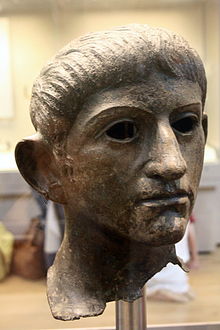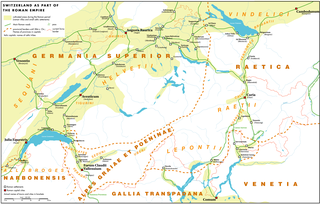
Boudica or Boudicca was a queen of the ancient British Iceni tribe, who led a failed uprising against the conquering forces of the Roman Empire in AD 60 or 61. She is considered a British national heroine and a symbol of the struggle for justice and independence.

The Roman conquest of Britain was the conquest of part of the island of Britain by occupying Roman forces. It began in earnest in AD 43 under Emperor Claudius, and was largely completed in the southern half of Britain by 87, when the Stanegate was established. Attempts to conquer Scotland (Caledonia) in succeeding centuries met with little sustained success.
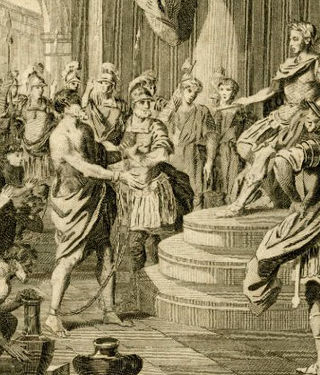
Caratacus was a 1st-century AD British chieftain of the Catuvellauni tribe, who resisted the Roman conquest of Britain.

Camulodunum, the Ancient Roman name for what is now Colchester in Essex, was an important castrum and city in Roman Britain, and the first capital of the province. A temporary "strapline" in the 1960s identifying it as the "oldest recorded town in Britain" has become popular with residents and is still used on heritage roadsigns on trunk road approaches. Originally the site of the Brythonic-Celtic oppidum of Camulodunon, capital of the Trinovantes and later the Catuvellauni tribes, it was first mentioned by name on coinage minted by the chieftain Tasciovanus some time between 20 and 10 BC. The Roman town began life as a Roman legionary base constructed in the AD 40s on the site of the Brythonic-Celtic fortress following its conquest by the Emperor Claudius. After the early town was destroyed during the Iceni rebellion in AD 60/61, it was rebuilt, reaching its zenith in the 2nd and 3rd centuries. During this time it was known by its official name Colonia Claudia Victricensis, often shortened to Colonia Victricensis, and as Camulodunum, a Latinised version of its original Brythonic name. The town was home to a large classical temple, two theatres, several Romano-British temples, Britain's only known chariot circus, Britain's first town walls, several large cemeteries and over 50 known mosaics and tessellated pavements. It may have reached a population of 30,000 at its height.
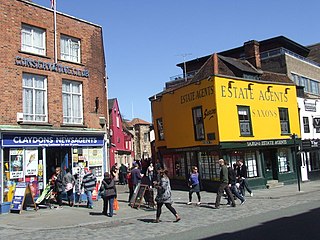
Colchester is a city in Essex, England. It is the largest settlement in Essex, having an urban population of 130,245 in 2021. The demonym is Colcestrian.
Togodumnus was king of the British Catuvellauni tribe, whose capital was at St. Albans, at the time of the Roman conquest. He can probably be identified with the legendary British king Guiderius. He is usually thought to have led the fight against the Romans alongside his brother, but to have been killed early in the campaign. However, some authorities now argue that he sided with the Romans and is one and the same person as the client-king Tiberius Claudius Cogidubnus, whose original name may have been Togidubnus or Togodumnus.
The title of oldest town in Britain is claimed by a number of settlements in Great Britain.

Colchester Castle is a Norman castle in Colchester, Essex, England, dating from the second half of the eleventh century. The keep of the castle is mostly intact and is the largest example of its kind anywhere in Europe, due to its being built on the foundations of the Roman Temple of Claudius, Colchester. The castle endured a three-month siege in 1216, but had fallen into disrepair by the seventeenth century when the curtain walls and some of the keep's upper parts were demolished; its original height is debated. The remaining structure was used as a prison and was partially restored as a large garden pavilion, but was purchased by Colchester Borough Council in 1922. The castle has since 1860 housed Colchester Museum, which has an important collection of Roman exhibits. It is a scheduled monument and a Grade I listed building.

Ancient Roman temples were among the most important buildings in Roman culture, and some of the richest buildings in Roman architecture, though only a few survive in any sort of complete state. Today they remain "the most obvious symbol of Roman architecture". Their construction and maintenance was a major part of ancient Roman religion, and all towns of any importance had at least one main temple, as well as smaller shrines. The main room (cella) housed the cult image of the deity to whom the temple was dedicated, and often a table for supplementary offerings or libations and a small altar for incense. Behind the cella was a room or rooms used by temple attendants for storage of equipment and offerings. The ordinary worshiper rarely entered the cella, and most public ceremonies were performed outside where the sacrificial altar was located, on the portico, with a crowd gathered in the temple precinct.

The British Iron Age is a conventional name used in the archaeology of Great Britain, referring to the prehistoric and protohistoric phases of the Iron Age culture of the main island and the smaller islands, typically excluding prehistoric Ireland, which had an independent Iron Age culture of its own. The Iron Age is not an archaeological horizon of common artefacts but is rather a locally-diverse cultural phase.

The Temple of Jupiter Optimus Maximus, also known as the Temple of Jupiter Capitolinus was the most important temple in Ancient Rome, located on the Capitoline Hill. It was surrounded by the Area Capitolina, a precinct where numerous shrines, altars, statues and victory trophies were displayed.
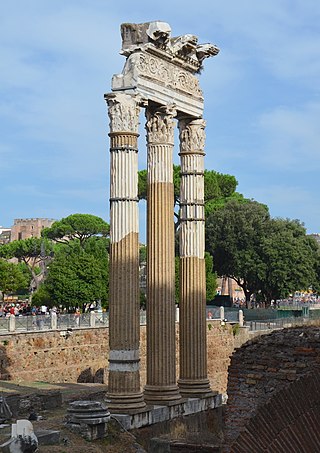
The Temple of Venus Genetrix is a ruined temple in the Forum of Caesar, Rome, dedicated to the Roman goddess Venus Genetrix, the founding goddess of the Julian gens. It was dedicated to the goddess on September 26, 46 BCE by Julius Caesar.
Colchester is a historic town located in Essex, England. It served as the first capital of Roman Britain and is the oldest recorded town in Britain. It was raided by the Vikings during the 9th and 10th centuries. It also served as an essential location for the medieval cloth trade.

The Temple of Concord in the ancient city of Rome refers to a series of shrines or temples dedicated to the Roman goddess Concordia, and erected at the western end of the Roman Forum. The earliest temple is believed to have been vowed by Marcus Furius Camillus in 367 BC, but it may not have been built until 218 BC by L. Manlius. The temple was rebuilt in 121 BC, and again by the future emperor Tiberius between 7 BC and AD 10.

The Temple of Hadrian is an ancient Roman structure on the Campus Martius in Rome, Italy, dedicated to the deified emperor Hadrian by his adoptive son and successor Antoninus Pius in 145 CE This temple was previously known as the Basilica of Neptune but has since been properly attributed as the Temple of Hadrian completed under Antoninus Pius. With one cella wall and eleven columns from the external colonnade surviving, the remains of the temple have been incorporated into a later building in the Piazza di Pietra, whereby its facade, alongside the architrave which was reconstructed later on, was incorporated into a 17th-century papal palace by Carlo Fontana, now occupied by Rome's Chamber of commerce. While only part of the structure remains, excavations and scholarship have provided us with information regarding its construction techniques and stylistic influences, helping us recreate the building dynamics and significance of the Temple of Hadrian in Imperial Rome.
The gens Asinia was a plebeian family at ancient Rome, which rose to prominence during the first century BC. The first member of this gens mentioned in history is Herius Asinius, commander of the Marrucini during the Social War. The Asinii probably obtained Roman citizenship in the aftermath of this conflict, as they are mentioned at Rome within a generation, and Gaius Asinius Pollio obtained the consulship in 40 BC.

A Romano-Celtic temple or fanum is a sub-class of Roman temple found in the north-western Celtic provinces of the Roman Empire. They were the main places of worship in Gallo-Roman religion. Romano-Celtic temples differ from classical Roman temples, and evidence shows they had much continuity with earlier Celtic temples. Many were built on earlier sacred sites of the Celtic religion.
The Temple of Zeus was the largest ancient Greek temple at Cyrene, Libya, and one of the largest Greek temples ever built. The original Doric octastyle peripteral temple was constructed around 500-480 BC, and heavily damaged in 115 AD. Later in the century, it was partially rebuilt as a non-peripteral temple with a colossal cult statue. It was destroyed once more in 365 AD by an earthquake and then burnt by Christians.


